CLASSROOM COMEDY
What Goes For Big Laughs Among English Teachers
HEREWITH,
WE LAUNCH a new series of old cartoons. Back in 1983, when I was on the
headquarters staff of the National Council of Teachers of English, I was
persuaded to draw cartoons for a Plan Book that would be sold to all and
sundry among the Council’s usual clientelle. In a moment of legendary weakness,
I agree to participate in the project but only if other staff members helped me
come up with the jokes. That way, I wouldn’t have take the rap for the whole
production—just the drawings. So that’s what happened. 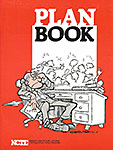
The cover of this tome appears nearby. I like a lot of the drawing—the silhouetted “students” in the distance and the typography (which I’ve tried unsuccessfully to find again)—and also the posture of the abused teacher, the way he fits into the chair, the turn of his right foot, and, particularly, the way the fingers of his left hand worked out. Nifty, I thought to myself when I finished it. But I must admit that the perspective of the desk top is all wrong. Sigh.
The
design of the Plan Book was calendar simple: each month was introduced
by a full-page cartoon, followed by four pages, one for each week in the month.
And each week’s page was topped with a thumbnail-sized cartoon about teaching
and teaching English in elementary and high schools. Among the first of the
book’s pages is the one for a September week. 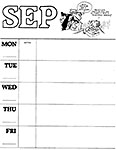 We won’t show any more full calendar pages
like this: we’ll show only the cartoons from those pages.
We won’t show any more full calendar pages
like this: we’ll show only the cartoons from those pages.
Many of the cartoons you’ll see were born on a couple balmy afternoons when a small group gathered over the wine bowl for gag writing sessions. (“Gags,” that’s what jokes are called in the argot of the trade.) We gagged for most of two afternoons, and some of the results you’ll eventually see. Those who bear some of the responsibility, then, include Mark Anderson, Paul O’Dea, Bernie O’Donnell, Holly O’Donnell, and Susan Clark of the National Council of Teachers of English staff, plus Carolyn Estes (Prairie High School, Frankfort, Indiana) for the question and answer gags and my daughters, Kit and Jill, and their mother, Linda, for insights into the elementary classroom.
This September page introduces one of the few continuing characters—the severe-looking man with an extended chin and a veined nose. He’ll show up a few more times as we wend our way, but apart from his appearance, he has no distinct personality. The same holds for a couple other continuing characters whom we’ll meet later.
Before
we leave September, here’s the full-page cartoon introducing the month. 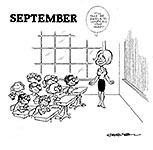 The full-pagers
generally had something to do with the month or time of year. September is the
beginning of the school year when teachers meet the scholars. Note that, ever
correct politically, some of the kids are racial minorities.
The full-pagers
generally had something to do with the month or time of year. September is the
beginning of the school year when teachers meet the scholars. Note that, ever
correct politically, some of the kids are racial minorities.
The teaching staff was represented in the Plan Book by as many women as men. (I haven’t counted them, but I think that’s true.) This one, another continuing character, is distinguished by her hair-do.
I love this joke, but maybe you have to be a former classroom teacher to be aware of all the subrosa nuances. Nuances? In this gag? Eh.
THE
SMALL CARTOONS on the tops of the weekly pages fall into four groups,
exemplified here (going clockwise from the upper left): “general” (any and all
topics), a cartoony representation of some common grammatical term, homework
excuses, and “Answers you (an English teacher) always wanted to give to
Questions you always get.” All are common classroom experiences. 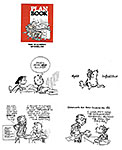
Except maybe the grammar stuff.
A split infinitive—in case you’ve forgotten—starts with the infinitive (to walk) and intrudes something (to slowly walk). There. Don’t you feel better already? One is supposed to eschew split infinitives, but I find them very friendly and use them all over the place to happily entertain myself.
My little split infinitive critter doesn’t actually illustrate the grammatical circumstance. He’s split, but a split infinitive has something between its two halves. I’ll do better next time.
The balding bespectacled teacher getting the homework excuse is another continuing character, but he appears only in the homework excuses cartoons.
When
I was teaching English in high school, every time I uttered that antique
advisory—You always takes the plural verb—I also muttered to myself what the
scholar is saying here.  The homework excuses get more and more extravagant as the
months fly by. The representation of a squinting modifier seems more accurate
than the split infinitive. Here (in case you’ve forgotten everything you
learned in an English class) is an example of a squinting modifier: Mary said during
the meeting Jo acted like a fool. “During the meeting” squints because it
could modify either “said” or “acted.” Did Mary say it during the meeting? Or
did Jo act like a fool during the meeting?
The homework excuses get more and more extravagant as the
months fly by. The representation of a squinting modifier seems more accurate
than the split infinitive. Here (in case you’ve forgotten everything you
learned in an English class) is an example of a squinting modifier: Mary said during
the meeting Jo acted like a fool. “During the meeting” squints because it
could modify either “said” or “acted.” Did Mary say it during the meeting? Or
did Jo act like a fool during the meeting?
Geez. I’m surprised I remember. Actually, I don’t: I had to look it up in my duty grammar book.
Our
next full-pager introduces the month of November. 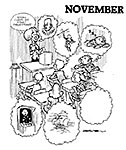 I’m not sure this is a joke. It is a
slice of truthiness, though—a vision of what a classroom of students might be
thinking when the dreaded “Shakespeare” unit is introduced.
I’m not sure this is a joke. It is a
slice of truthiness, though—a vision of what a classroom of students might be
thinking when the dreaded “Shakespeare” unit is introduced.
Then
we have an assortment of our usual gang. 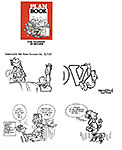 The homework excuse is highly dramatic
here—exaggerated and therefore comic; and the dangling verbal is actually
dangling (off the end of the abbreviated “November”). A dangling verbal, or modifier,
in case your memory has deserted you, is a modifier that has no word in the
sentence which it can sensibly modify. Here’s one: After eating a hearty
supper, the dishes were washed. The dishes didn’t eat a hearty supper but
that’s the only word in the sentence to which the modifier could apply. It can
be fixed like this: After eating a hearty supper, we washed the dishes. See how
complex and intricate?
The homework excuse is highly dramatic
here—exaggerated and therefore comic; and the dangling verbal is actually
dangling (off the end of the abbreviated “November”). A dangling verbal, or modifier,
in case your memory has deserted you, is a modifier that has no word in the
sentence which it can sensibly modify. Here’s one: After eating a hearty
supper, the dishes were washed. The dishes didn’t eat a hearty supper but
that’s the only word in the sentence to which the modifier could apply. It can
be fixed like this: After eating a hearty supper, we washed the dishes. See how
complex and intricate?
I like the frustrated alarm depicted in the homework excuse teacher. His hands are just right. And the kid wanting to know about his ‘F’—his outstretched arm/hands are nicely expressive, I ween. I suppose, about the last cartoon, that English teachers listen to poetry rather than music when they jog with a headset on. (Robert Frost is quoted; but you knew that, right?)
Next,
we come to Christmas. Every holiday vacation, you’ll remember, was usually
clogged with homework. Book reports due when classes resumed after the holiday.
Teachers faced somewhat the same problem as their students: usually teachers had
term papers to grade, and they often had enough accumulated over the fall
months to heap up 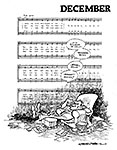 for grading during the holiday vacation. It was enough to
drive a person to drink. And that’s why our hapless English teacher is sitting
here, in December—on the cusp of the holiday—mentally turning holiday chores
into holiday cheers.
for grading during the holiday vacation. It was enough to
drive a person to drink. And that’s why our hapless English teacher is sitting
here, in December—on the cusp of the holiday—mentally turning holiday chores
into holiday cheers.
I like the picture. It has a lot of tiny refinements that I dote on. The finger on his forehead with a line not quite completed: I look for these opportunities and delight when they come along. His sprawl, legs extended, pants wrinkling a little. Nice. And he looks so relaxed, so submerged into his easy chair. So comfortable.
IN
THE NEXT PAGE OF WEEKLY CARTOONS, we encounter the first of a 2-panel
cartoon—running across the top of the page. This records for posterity one of
the verbal exchanges that inevitably takes place in any social situation in
which an English teacher finds him/herself. 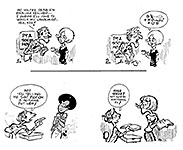 Everyone expects that you’re judging their lack
of command of the grammar of the language—which is what the guy in the first
panel assumes. Heh, heh. That’s the cliche situation. The teacher’s response in
the second panel is not the standard response but many of us were tempted to
say exactly that.
Everyone expects that you’re judging their lack
of command of the grammar of the language—which is what the guy in the first
panel assumes. Heh, heh. That’s the cliche situation. The teacher’s response in
the second panel is not the standard response but many of us were tempted to
say exactly that.
Instead, we were likely to smile and say, “Oh, that’s okay. I’ll watch it for you.”
We also record here the first racial minority to appear in the Plan Book. There are several more as we’ll see later. The high school I taught in had virtually no racial minorities on the faculty even though it was, technically speaking, an inner city school with a huge African-American population. The vice principal was African-American, but he was alone.
Next,
another of the month division pages in the Plan Book, this one starring our
peevish-looking professorial type in a little drama that gives life to the old
expression applied to English teachers as “custodians of the language.” 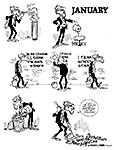 On the second tier
(in case you’ve forgotten the fundamentals of the highschool English class you
were sentenced to), he’s eliminating redundancy: “In my opinion” and “I think”
are the same statement. But you knew that, eh? I know you know it.
On the second tier
(in case you’ve forgotten the fundamentals of the highschool English class you
were sentenced to), he’s eliminating redundancy: “In my opinion” and “I think”
are the same statement. But you knew that, eh? I know you know it.
Two
of the cartoons at hand in our next display are in two of the repeating
categories—excuses for missing homework, and answers you always wanted to give
to questions you’re always asked. 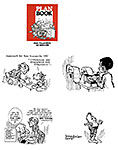 The kid typing on toilet tissue is another of our
attempts to keep the classroom characters diverse.
The kid typing on toilet tissue is another of our
attempts to keep the classroom characters diverse.
I typed term papers in somewhat this fashion when in college. I used a roll of teletype paper, borrowed from the campus newspaper office. I’d grab one of the books I was consulting and find things to quote; I’d subsequently footnote the quotes in the finished paper after connecting them with some sort of narrative. I’d just type merrily along, quoting from book after book, rolling the teletype paper into the typewriter as I typed. If it was a 12-page paper that was due, I’d stop quoting and typing when I had filled 12 feet of the teletype roll. I’d tear it out of the typewriter, cut all the quotes apart, arrange them in what seemed to be a logical order, and then write (type) sentences that would connect the quotes. Worked fine.
My bodiless head character returns to illustrate “irregular verb.” His trousers are irregular. Ha.
At
the top of the next page of weekly cartoons, we have another quick-witted
response to questions teachers are always asked and yet another excuse for not
doing homework—plus a long, horizontal cartoon that was printed across the tops
of two of the week pages in the Plan Book. 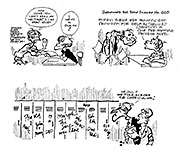 “Writing across the curriculum” refers to a
pedagogical theory that recommends teaching writing in all subjects, not just
English.
“Writing across the curriculum” refers to a
pedagogical theory that recommends teaching writing in all subjects, not just
English.
As
I mentioned before—when we began this expedition into the class planning book I
cartooned for years ago—every month of the Plan Book began with a full-page
cartoon. And near here is February’s. 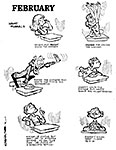 The month, in this instance, has nothing to do
with the gag, a visualization of the meaning in how a student raises his hand
in response to a teacher’s question. But you don’t have to be a teacher (or, in
my case, an ex-teacher) to recognize the types. While each
The month, in this instance, has nothing to do
with the gag, a visualization of the meaning in how a student raises his hand
in response to a teacher’s question. But you don’t have to be a teacher (or, in
my case, an ex-teacher) to recognize the types. While each 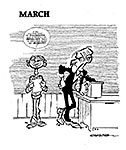 picture is
ostensibly funny in itself, the series builds to the final picture as a
punchline.
picture is
ostensibly funny in itself, the series builds to the final picture as a
punchline.
Next, we have another month division page in the Lesson Plan Book.The grumpy teacher and a snotty kid. I like the drawing, but the joke resides in the words.
IN
THENEXT ASSEMBLAGE OF WEEKY CARTOONS are two “Homework Not Done Excuses”; dunno
why. 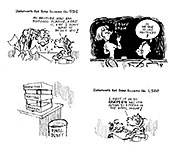 Maybe I
was running out of the other gags. There is one more of this series, so we’re
not quite done—even though, judging from the teacher’s diminished posture in
the lower right, it looks like we might be.
Maybe I
was running out of the other gags. There is one more of this series, so we’re
not quite done—even though, judging from the teacher’s diminished posture in
the lower right, it looks like we might be.
Otherwise, the gags are, as usual, English-teacher oriented.
All
three of the continuing cartoon categories appear in our next exhibit— the
Answers You Always Wanted to Give to Questions You Always Get, Homework Not
Done Excuses, and the little nebbish talking head, who, in this appearance,
doesn’t quite speak. Or does he? 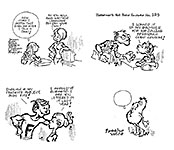
This is the last appearance for all three of these joke-types. After this, the comedy must go on without the comfort of the familiar (so to speak).
I’m happy to see that facial expression plays a role in all of these. I particularly like the teacher collecting the homework. Peeved, exasperated—maybe just a little desperate. After all, he’s been coming up empty-handed for weeks.
And the hair-do of the little girl in the first cartoon is very up-to-date for 1983, the year these cartoons were printed in the Lesson Plan Book.
Here’s
another month division page, this one, for April (the cruelest month according
to Robbie Burns). 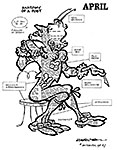 The picture here could be of Shakespeare, the month of April allegedly
being his birth month. Could be but isn’t. Just a poet with his insides on
display for us all to marvel at.
The picture here could be of Shakespeare, the month of April allegedly
being his birth month. Could be but isn’t. Just a poet with his insides on
display for us all to marvel at.
The text showing through appears to be copies of pages of a rhyming dictionary. What poet would be without one for his/her innards?
Otherwise, it’s a collection of visual-verbal puns. Wot fun, eh?
Next
up, more spot cartoons from the individual week-by-week pages of the Lesson
Plan Book. 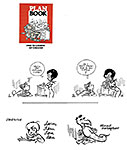 On this display, we have a two-panel cartoon stretched across the page. I like
the teacher’s expression in the second panel, and the little bubbles of vaguery
over the kid’s head in the first.
On this display, we have a two-panel cartoon stretched across the page. I like
the teacher’s expression in the second panel, and the little bubbles of vaguery
over the kid’s head in the first.
Cursive handwriting is no longer taught in many schools these days. Since everyone will be communicating via typed messages on the Internet, why learn to write at all? They all learn to print but not to write cursive. Sad.
Our
cranky professor is back in the first cartoon of this culling, but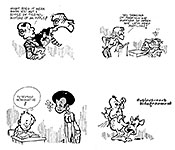 he is merely
there and says nothing.The joke belongs to his comrade. “Petrified nominative” is a
part of speech I think I invented (or else surreptitiously stole from someone
else); I used to throw it out in those endlessly esoteric conversations English
teachers love to have about grammar. And I like “subject-verb disagreement”:
the characters are just too charming and accurate for, er, words. So I should
stop here, eh?
he is merely
there and says nothing.The joke belongs to his comrade. “Petrified nominative” is a
part of speech I think I invented (or else surreptitiously stole from someone
else); I used to throw it out in those endlessly esoteric conversations English
teachers love to have about grammar. And I like “subject-verb disagreement”:
the characters are just too charming and accurate for, er, words. So I should
stop here, eh?
NO
SUCH LUCK. Here’s a little quiz for you. (Well, we’re back in the classroom,
kimo sabe—site of many many quizes.) 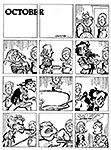 This is the October monthly division page, but the month has nothing to do with
the so-called jokes (or vice versa). How many of the characters (authors and/or
their creations) parading by can you name? I particularly like the combination
in panels 7 and 8. Who?
This is the October monthly division page, but the month has nothing to do with
the so-called jokes (or vice versa). How many of the characters (authors and/or
their creations) parading by can you name? I particularly like the combination
in panels 7 and 8. Who?
Another
month division page, this one, a commemoration of the countless reports
teachers are required to make, all time-consuming in professional lives with
little time to spare. 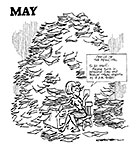 In the Navy, we “gun-decked” such reports—that is, we found ways to
dummy-in the reports without actually doing what was requred. Once I received
notice that I hadn’t, lately, been submitting my “fan blade” report. We were
supposed to inspect all fans in our “spaces” to be sure none of the fan blades
were bent (and therefore dangerous). Exasperated, I grabbed a handful of 8 ½ x
11-inch paper from the wastebasket—discarded documents of one sort or
another—wrote a memo saying “attached is my fan blade report,” stapled the
handful of sheets to the memo and shipped it off. Never heard from anyone about
it, one way or another.
In the Navy, we “gun-decked” such reports—that is, we found ways to
dummy-in the reports without actually doing what was requred. Once I received
notice that I hadn’t, lately, been submitting my “fan blade” report. We were
supposed to inspect all fans in our “spaces” to be sure none of the fan blades
were bent (and therefore dangerous). Exasperated, I grabbed a handful of 8 ½ x
11-inch paper from the wastebasket—discarded documents of one sort or
another—wrote a memo saying “attached is my fan blade report,” stapled the
handful of sheets to the memo and shipped it off. Never heard from anyone about
it, one way or another.
I like the treatment of the heap of paper. Just enough individualized sheets to suggest thousands more.
Across
the top of our next visual aid is a 2-panel cartoon—about computers in the
classroom, a fairly new venture in 1983 when the Plan Book was produced.
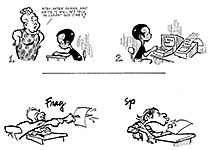 Across the
bottom are two enactments of the cryptic notes English teachers were wont to
scribble on student compositions. “Frag” means “sentence fragment”; “sp”
indicates a spelling error. (But you all knew that, eh? Your incarceration in
high school English class must’ve “took,” as they say. So—just to test you—what
is a sentence fragment? One without a verb, usually—or, sometimes, even a
subject. Like the one I just typed.)
Across the
bottom are two enactments of the cryptic notes English teachers were wont to
scribble on student compositions. “Frag” means “sentence fragment”; “sp”
indicates a spelling error. (But you all knew that, eh? Your incarceration in
high school English class must’ve “took,” as they say. So—just to test you—what
is a sentence fragment? One without a verb, usually—or, sometimes, even a
subject. Like the one I just typed.)
I particularly like the body language of the Frag kid; and the facial expression on the Sp kid.
The
first of the next four cartoons dramatizes the notation English teachers are likely
to make on a student composition next to a sentence that is “awkward” in
construction or meaning. 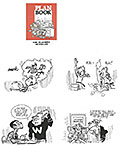 Then we have a student’s dramatic enactment
of a piece of poetry. Next, the deployment of a stereotypical image of a
football player. The “W” on his chest was probably my dim recollection of my
short 5-year career as a classroom teacher at Wyandotte High School in Kansas
City, Kansas.
Then we have a student’s dramatic enactment
of a piece of poetry. Next, the deployment of a stereotypical image of a
football player. The “W” on his chest was probably my dim recollection of my
short 5-year career as a classroom teacher at Wyandotte High School in Kansas
City, Kansas.
Finally, more drama—on the face of the teacher who tried to teach the difference between “lie” and “lay.” I like his face and body language.
Next,
we approach both the end of the school year and the end of this exposition with
the monthly division page for the month of June. 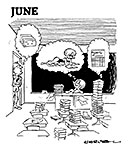 Because school usually let
out early in the month, we don’t have any weekly planning pages after this
division page.
Because school usually let
out early in the month, we don’t have any weekly planning pages after this
division page.
Clearly,
it’s the end of the year. The principal is thinking about the teacher getting
all her grade cards turned in (the old IBM punched variety), and the teacher is
day-dreaming about how she hopes to spend the coming summer. The joke—such as
it is—is in what the stacks of books are thinking: someone (alas, the teacher)
has to log them all in, making sure every kid has turned in his books by
checking the nameplate inside the front cover against the class roster. More
work for the teacher before she can adjoin to the beach. 
The last page in the Lesson Plan Book I devoted to a little autobiographical insight. I like this strip. It’s authentic, for one thing, drawing on my experience as a classroom teacher. I taught seniors, which means at the end of every school year, they all left, and most of them I never saw again. Sob.
I like this strip for another reason: as an example of comic strip storytelling, it exploits the medium’s capacity for small bore drama by timing the speech and linking it to action with a somber final panel. Lights out.
